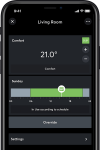What Is Smart Heating?
What Is Smart Heating?
This year, more people than ever will install some form of ‘smart’ heating in their home. There are many reasons behind this, but since heating makes up over 60% of most energy bills, the driving factor that has got us Googling ‘smart heating’ in droves is the promise of reduced costs and increased comfort at home.
Smart Thermostats
Chances are, you’re probably already aware of some of the options available for controlling your heating since there are already several ‘smart thermostats’ available on the market.
Many ‘smart heating’ products, such as smart thermostats, set the expectation for consumers that heating needs to be manually controlled via an app. A much more convenient and efficient option; however, is a dynamic, learning heating system that knows when you are using rooms within your home and adjusts temperatures automatically. This type of smart heating system lowers the heating automatically when you are not at home and raises the temperature ready for your return home, all without the need for an app.
Smart heating apps offer a convenient and flexible way to interact with your heating system. For instance, the ability to adjust the heating from afar can be very appealing to those with unpredictable schedules, or when returning from holiday. Remote heating control can also be handy for those with holiday homes which they rent out to holidaymakers – they can ensure the house is warm and cosy whilst in use, and double check that the heating is not running during periods of vacancy.
Whilst apps do offer many advantages, we believe that they should not be at the center of your heating control. We think a smart home should just get on with things and run to a schedule with minimal interaction. After all, who wants to constantly get their phone out to adjust the heating, switch the lights on and so on?
Unlike the other solutions mentioned above, Loxone has a central brain, the Miniserver, that can control not just heating, but lighting, security, AV and more. By installing a Miniserver, you have the foundation for a whole Smart Home. You could then control several other aspects of your home without needing to buy another hub or use another app. In addition, the potential for saving money on your energy bills is even greater with zoned heating.
So is it worth it?
There’s no doubt that smart thermostats can save you money on your heating bills. However, the manufacturer’s claims about savings are probably on the high side when one looks closely. Despite the initial cost of buying and installing a smart thermostat, most will pay for themselves within 2 years and with energy prices only set to go upwards, the benefits can only increase.
The Downside…
The biggest issue with smart thermostats is that like their predecessors, they can only control the temperature for a single zone – usually the whole house. The problem here is that many older thermostats languish in a sequestered spot like the hallway, where it’s usually several degrees cooler than the rest of the house. This means that the true temperature in the house is never quite as the thermostat suggests.
If you’re looking to really maximise efficiency when it comes to heating, a zoned heating system is a better choice than a single thermostat.
I’m considering investing in a smart heating control system, what kinds of features should I be looking out for?
There are a few key questions to consider if you’re looking at investing in a smart heating control system. This might include:
- Can you control temperatures individually in the rooms or zones of your home?
- Are there options to create a heating ‘boost’ or override?
- Is it a self-learning or ‘smart start’ system? Can it learn how long it takes to reach your desired temperature and start heating in time for the house to be at the right temperature for the time you have specified?
- Are there options for ‘Holiday’ or ‘Away’ modes, so that you can lower the heating whilst you’re away from home?
- Does your system include motion-based heating – so if you remain in a room longer than expected, the room stays warm?
- Future expansion – could this solution control other aspects of your home, if you’d like it to?
- Is the system intelligent? So, if a window or door is left open, will it recognise not to crank up the heating to try and reach the desired temperature so as not to waste energy?
Copyright © KtirioService 2006-2025. All Right Reserved.
Designed & developed by webgift.



